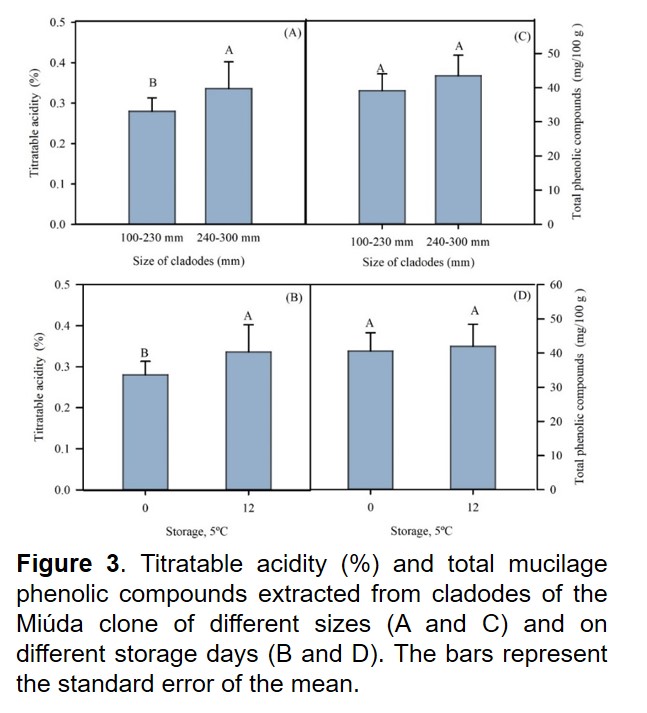Size and harvest time of cladodes modulate the composition and physicochemical stability of prickly pear cactus mucilage
DOI:
https://doi.org/10.56890/jpacd.v24i.508Palabras clave:
Nopalea cochinillifera L. Salm-Dyck, pH, Principal component analysis (PCA), Stability, Total Soluble CarbohydratesResumen
The objective was to carry out a physicochemical characterization of the mucilage obtained from different sizes of cladodes harvested at different times. Nopalea cochenillifera Salm Dyck cladodes were collected in two sizes (100 to 230 and 240 to 300 mm), at two different times (6 am and 8 pm), and processed for mucilage extraction. This was dried in an oven, and then hydrated and kept at 5 °C for 12 days. The mucilage yield after harvest was quantified, in addition to the characterization of the main bands in the infrared region. In the mucilage, the following physicochemical analyzes were performed: K+ and Na+ content, electrical conductivity, titratable acidity, pH, total phenolic compounds, vitamin C, total soluble solids, total soluble carbohydrates, total soluble proteins after harvest (day 0), and to the 12 days of storage at 5 ºC. Correlation between the variables was determined through principal component analysis (PCA). The highest mucilage yield was obtained in cladodes harvested at 6 am, regardless of size. The 6 am harvest showed higher acidity and protein content and lower concentrations of soluble solids, EC, Na+, K+, vitamin C, carbohydrates, and phenolic compounds. In conservation, the mucilage of the cladodes with sizes between 100 and 230 mm and the harvest at 6 am showed greater stability. Principal component analysis (PCA) showed a tendency of formed groups between different sizes, harvest times, and conservation days, indicating that different conditions for obtaining the cladodes result in differences in the composition and stability of the mucilage. Thus, the results show that, in addition to the climatic conditions, as proposed by other authors, the harvest time and the size of the cladode modulate the physicochemical and important ion composition and stability, which can change the technological and industrial applications of mucilage.
##plugins.generic.pfl.publicationFactsTitle##
##plugins.generic.pfl.reviewerProfiles## N/D
##plugins.generic.pfl.authorStatements##
Indexado: {$indexList}
-
##plugins.generic.pfl.indexedList##
- ##plugins.generic.pfl.academicSociety##
- Journal of the Professional Association for Cactus Development
- Editora:
- Professional Association for Cactus Development




